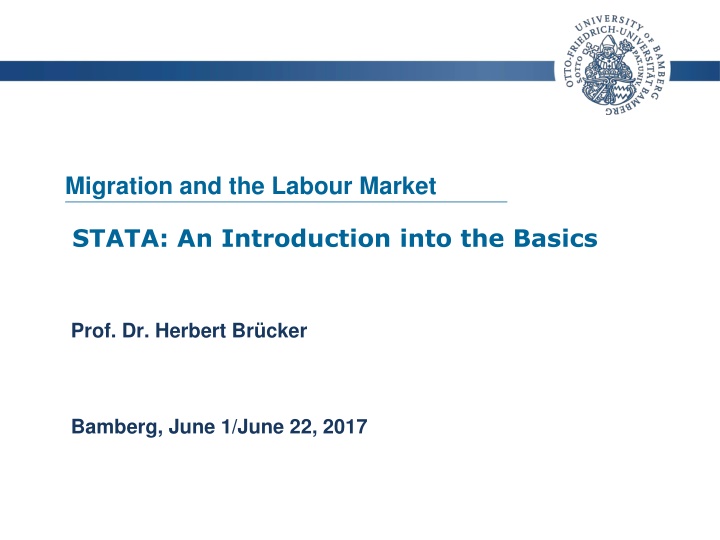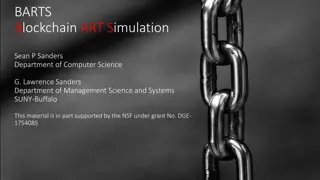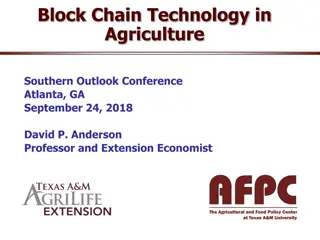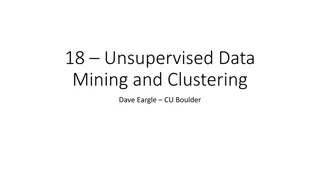
Blockchain in the Public Sector: A Forward Look
A forward look at blockchain technology in the public sector, highlighting its potential impact, policy implications, and the importance of rebuilding trust in state institutions. The OECD Blockchain Policy Centre's initiatives, research publications, and the role of blockchain in digital government maturity are discussed. The content emphasizes the value of decentralized finance, responsible development of DLT, and cross-border applications for enhancing certainty in blockchain solutions.
Download Presentation

Please find below an Image/Link to download the presentation.
The content on the website is provided AS IS for your information and personal use only. It may not be sold, licensed, or shared on other websites without obtaining consent from the author. If you encounter any issues during the download, it is possible that the publisher has removed the file from their server.
You are allowed to download the files provided on this website for personal or commercial use, subject to the condition that they are used lawfully. All files are the property of their respective owners.
The content on the website is provided AS IS for your information and personal use only. It may not be sold, licensed, or shared on other websites without obtaining consent from the author.
E N D
Presentation Transcript
Migration and the Labour Market STATA: An Introduction into the Basics Prof. Dr. Herbert Br cker Bamberg, June 1/June 22, 2017
Migration and the Labor Market Session 3: STATA: An Introduction into the Basics Contents I II III What do we have to do for the paper Brief introduction into the datasets Introduction into STATA 1 STATA Software Package 2 STATA Basics: three files 3 Getting started 4 The STATA Menues 5 The Grammar of STATA 6 Working with Do-Files 7 Organizing your session 8 Processing your data 9 Describe your data 10 Making graphs
Migration and the Labor Market Session 3: STATA: An Introduction into the Basics I What do we have to do for the paper? 1 2 State of research (brief literature review) Defining the question 1 Wage effects of immigration 2 Employment effects Preparing the dataset 1 Generating Dummy Variables 2 Generating/Transforming other Variables Describing the data 1 Data sources 2 Descriptive statistics 3 Graphs Running simple regression models Presentation in class and drafting the paper 3 4 5 6
Migration and the Labor Market Session 3: STATA: An Introduction into the Basics Recall the Borjas (2003)-Modell where yijtis the dependent variable (e.g. log wage, unemployment rate) siis an education dummy xjis an work experience dummy tis a time dummy plus many interaction dummies This is what we want to estimate. For this we need certain tools, inter alia STATA knowledge.
Migration and the Labor Market Session 3: STATA: An Introduction into the Basics A brief intro into the data
Migration and the Labor Market Session 3: STATA: An Introduction into the Basics What is important to know about the data The data are derived from micro data (cumbersome) Denmark: IDA register data (social security data) whole universe of the population Germany: IEB register data (social security records) 5% sample UK: Labour Force Survey data 0,5-1% sample of population Differences Country of birth (DK, UK), nationality and past nationality (DE) Education: degrees (DE and DK), years of schooling (UK) due to educational systems Many, many details
Migration and the Labor Market Session 3: STATA: An Introduction into the Basics What is important to know about the data Literature reference: Br cker, Herbert; Hauptmann, Andreas, Jahn, Elke, Upward, Richard (2014), Migration and imperfect labour markets. Theory and cross-country evidence from Denmark, Germany and the UK , in: European Economic Review, Vol. 66, pp. 205-225.
Migration and the Labor Market Session 3: STATA: An Introduction into the Basics How have we organized the datafile? Year: Education: 3 groups by degree (DE, DK) or years of schooling (UK) Experience:4 groups by work experience (0-5, 6- 10, 11-20, over 20) Hsumwage: Wagesum of native workers (LHt*wht) Fsumwage: Wagesum of immigrant workers (LFt*wft) LHqjt: Number of workers by nationality, education, workexperience and year UHqjt: Number of unemployed workers by nationality, education and workexperience and year NHqjt: Labour force (L+U) by nationality, education, work experience and year 19XX to 20XX
Migration and the Labor Market Session 3: STATA: An Introduction into the Basics How have we organized the datafile? wHqjt: wage of workers by nationality, education, workexperience and year mean wage aggregate by nationality and education and year mean wage aggregate by nationality and year mean wage aggregate by year wHqt: wHt: wt Same for L, U, and N Indices: H, F: q: j: t: Natives, Immigrants education work experience time (year)
Migration and the Labor Market Session 3: STATA: An Introduction into the Basics Working with STATA: Introduction into the Basics
Migration and the Labor Market Session 3: STATA: An Introduction into the Basics Best STATA textbook in German: Ulrich Kohler / Frauke Kreuter: Datananalyse mit STATA: allgemeine Konzeote der Datenanalyse und ihre praktische Anwendung, 4. Auflage, Oldenbourg Verlag.
Migration and the Labor Market Session 3: STATA: An Introduction into the Basics 1 STATA SOFTWARE PACKAGE 1. Connect to Bamberg University datanet via cable, WLAN or VPN 2. Switch to \\lizenz01.rz.uni-Bamberg.de\Stata_SoWi 3. Insert your username in format uni-Bamberg.de\BA-Kennung 4. Use START_Stata_SoWi button to start Software (doubleclick) Note that this may need several minutes (usually 3-5 minutes) 5. Support: it-support@uni-Bamberg.de, fon: 0951 863-1333 6. Note: there only 50 licences. Close Stata if you don t use it
Migration and the Labor Market Session 3: STATA: An Introduction into the Basics 2 Structure of STATA: Three files 1. The DATA file (.dta) where you have your data. You can watch you data with the DATA BROWSER and edit your data with the DATA EDITOR The DO file (.do) where you run and save your commands of any session. Very useful (i) to organise your data set, (ii) to see what you have done in the last session, (iii) to replicate what you have done in last session, (iv) to exchange work with your collaborators. You write and run your commands with the DO FILE EDITOR 2.
Structure of STATA: Three files Migration and the Labor Market 2 Session 3: STATA: An Introduction into the Basics 3. The LOG file (.scmf) which automatically reports all things which you have done during your session. Is automatically saved after your session. Useful if something goes wrong.
Migration and the Labor Market Session 3: STATA: An Introduction into the Basics 3 Getting started: the STATA empty window
Migration and the Labor Market Session 3: STATA: An Introduction into the Basics 3 Getting started: The STATA empty window The main window: shows commands, output and messages which arrive during your session
Migration and the Labor Market Session 3: STATA: An Introduction into the Basics 3 Getting started: The STATA empty window The main window: shows commands, output and messages which arrive during your session The command window: here you can type your commands
Migration and the Labor Market Session 3: STATA: An Introduction into the Basics 3 Getting started: The STATA empty window The main window: shows commands, output and messages which arrive during your session The variables window: Shows variables of your dataset The command window: here you can type your commands
Migration and the Labor Market Session 3: STATA: An Introduction into the Basics 3 Getting started: The STATA empty window The review window reports your previous commands The main window: shows commands, output and messages which arrive during your session The variables window: Shows variables of your dataset The command window: here you can type your commands
Migration and the Labor Market Session 3: STATA: An Introduction into the Basics 3 Getting started: the windows after data loading Reports commands (one in this case) Reports result of commands List of variables
Migration and the Labor Market Session 3: STATA: An Introduction into the Basics 3 Getting started In principle, you can start your STATA session by (i) loading your data set and (ii) typing your commands in the command window. It is however recommended to use the DO FILE EDITOR right from the beginning. But let s look at the STATA menues first.
Migration and the Labor Market Session 3: STATA: An Introduction into the Basics 4 The STATA Menues The data path The do file editor The data editor The data browser The variables manager The help menue For watching your data and changing your data by hand you need the DATA BROWSER and the DATA EDITOR. For starting and running your DO files you need the DO FILE EDITOR. The other menues are not relevant for the beginning.
Migration and the Labor Market Session 3: STATA: An Introduction into the Basics 4 The STATA Menues: The DATA EDITOR/BROWSER The difference between the data browser and the data editor is that you can manipulate data in the editor and only watch them in the browser.
Migration and the Labor Market Session 3: STATA: An Introduction into the Basics 4 The STATA Menues: The DATA EDITOR/BROWSER Numerical variable labelled NUMERICAL variable You have two types of variables: NUMERICAL variables (black or blue) and so-called STRING variables (red) (e.g. text). STATA can identify STRING variables, but you cannot do numerical operations with them.
Migration and the Labor Market Session 3: STATA: An Introduction into the Basics 4 The STATA Menues: The DATA EDITOR/BROWSER HINT: You can transfer data e.g. from an EXCEL file into a STATA file by copy and paste (STRG C + STRG V) and vice versa in the data editor. But you have to be careful that you EXCEL is run in English, otherwise your data might be read as STRING variables by STATA. Better: Use the import excel command.
Migration and the Labor Market Session 3: STATA: An Introduction into the Basics The Grammar of STATA 5 General Structure of STATA commands [prefix :] command [varlist] [if] [in] [weight] [, options]
Migration and the Labor Market Session 3: STATA: An Introduction into the Basics Grammar of STATA We will concentrate on: [prefix :] command [varlist] [if] [in] [weight] [, options]
Migration and the Labor Market Session 3: STATA: An Introduction into the Basics Commands [prefix :] command [varlist] [if] [in] [weight] [, options] What you want to do? Examples: regress (make a regression) summarize (make summary statistics) graph twoway line (make a graph)
Migration and the Labor Market Session 3: STATA: An Introduction into the Basics Commands: using abreviations [prefix :] command [varlist] [if] [in] [weight] [, options] Examples: r or reg instead of regress s or sum instead of summarize g instead of graph
Migration and the Labor Market Session 3: STATA: An Introduction into the Basics Grammar of Stata: Variables [prefix :] command [varlist] [if] [in] [weight] [, options] varlist is a list of variables, which you have in your dataset Examples: wft is the foreign wage Lft the foreign labor force You can also use list of variables which comprises a number of variables you have defined before (see working with globals below).
Migration and the Labor Market Session 3: STATA: An Introduction into the Basics Grammar of STATA: the if-condition [prefix :] command [varlist] [if] [in] [weight] [, options] The if condition constrains what you do to a certain condition you have defined. Example: You want to replace a variable with certain values if the individuals have higher education: replace ed3 = 1 if education == 3
Migration and the Labor Market Session 3: STATA: An Introduction into the Basics Grammar of STATA: the if-condition (cont.) [prefix :] command [varlist] [if] [in] [weight] [, options] Another example: You want to restrict a regression to subsample, e.g. to foreigners only: reg wqjt mqjt Dqjt Djt Dt if Nft > 0
Migration and the Labor Market Session 3: STATA: An Introduction into the Basics Grammar of STATA: Options [prefix :] command [varlist] [if] [in] [weight] [, options] Options are very often complementing commands, e.g. you can run a regression with fixed effects. Example: xtreg wqjt mqjt Dqjt Djt, fe where fe is the option for fixed effects.
Migration and the Labor Market Session 3: STATA: An Introduction into the Basics Grammar of STATA: types of variabes There are two types of variables (data): numerical variables, e.g.: 0, 1, 501, 0.5, -12 etc. string variables, e.g.: no voc train , male, female etc. How to deal with the data types: Numerical variables: you can do all mathematical operations, e.g. var1 + var2, var1/var2, var1*var2 etc. String variables: You have to use quotation marks for identification, e.g. var1 = 1 if sex == female
Migration and the Labor Market Session 3: STATA: An Introduction into the Basics 6 Working with DO FILES: General issues The standard approach is to start your work with a DO FILE Click on the DO FILE editor button after starting STATA Load an existing DO FILE or start a new one Save the DO File at the end of your session
Migration and the Labor Market Session 3: STATA: An Introduction into the Basics Open your DO FILE editor The Do-file editor After starting STATA click on the DO FILE editor button
Migration and the Labor Market Session 3: STATA: An Introduction into the Basics How does a DO FILE look like Descriptions of what you have done in stars * Commands
Migration and the Labor Market Session 3: STATA: An Introduction into the Basics The DO FILE menue Clicking this button runs the entire DO FILE (not recommended) Clicking this button runs a selection of marked commands (recommended) Note: STATA stops the DO File execution after the first mistake in your commands. That makes it advisable to proceed step by step.
Migration and the Labor Market Session 3: STATA: An Introduction into the Basics 7 Organizing your session: General issues The basis for all what you do is your Do-File which you open in all sessions first Work with a small data set and do the generation of all additional variables based on your Do-File in the beginning of each session. Save only the small dataset. That is efficient from the data management side and reduces the risk that you delete/change important variables which you cannot restore. Change somewhere a save version of your dataset Use a LOG File that you can see in case of a problem what you have actually done. You seldomly look at it, but you might miss it in an important case At end of session save the Do-file and close Log file Close data-file but do not save it: this can destroy your dataset!
Migration and the Labor Market Session 3: STATA: An Introduction into the Basics Starting your session: Step 1 Begin your Do-file with the following useful commands: set more off Is not necessary but useful Helps data processing e.g. in long regressions, long statistics capture log close closes log file if one is open the capture (cap) command is useful since STATA executes this command only if it is need, e.g. if a log file is open log using path\DE , replace Opens a Log-File with the name DE
Migration and the Labor Market Session 3: STATA: An Introduction into the Basics Step 2: Loading your data If you have already a STATA data file: The use command loads the data the path\data\DE.dta, clear provides STATA the information on the path where to find the data and the name of the data file (e.g. DE.dta) the clear command after the comma clears the memory, which is needed if you have used other data sets before Path is the path where STATA can find your data, e.g. C:\\Users\Herbert\Documents\STATA\ Projectseminar_2016
Migration and the Labor Market Session 3: STATA: An Introduction into the Basics Loading your data (I/II) 1. Write the command use path\XXX.dta , clear 2. Mark the line and run the command by clicking the execution button
Migration and the Labor Market Session 3: STATA: An Introduction into the Basics Loading your data (II/II)
Migration and the Labor Market Session 3: STATA: An Introduction into the Basics Loading your data from EXCEL If you have to import data e.g. from an Excel file: Use the import excel using path\data\de.xlsx, firstrow command the import excel tells STATA that it has to import a file with a different data format, in this case excel using path\data\de.xlsx tells data where to find the data and the file name The option after the comma , firstrow tells STATA that it has to treat the first row of the Excel sheet as the names (labels) of the variables. Otherwise it thinks it are data and you end up in a mess.
Migration and the Labor Market Session 3: STATA: An Introduction into the Basics Ending your session Save your Do-file, e.g. save uk.do Close your Log-file: log close Attention: in normal cases don t save your Data-file. If you do this, all changes in your data set are saved and the original data set might be destroyed. You cannot restore the old dataset once it is saved. Of course, if you want to save some changes of your dataset, you can save it.
Migration and the Labor Market Session 3: STATA: An Introduction into the Basics 8 Processing your data Your can generate new variables and replace existing ones E.g. generate a numerical variable by using the information from a STRING variable gen ed = . generates the variable ed with missing values in the first place In the next step you can replace the values of this variables by using replace ed = 1 if education == no voc training Which assigns the varianble a value of 1 if the person/group has no vocational training
Migration and the Labor Market Session 3: STATA: An Introduction into the Basics Generating new variables replace ed = 1 if education == no voc training replace tells STATA to replace the values of the variable, in this case of the ed variable by 1 the if option tells STATA under which conditions, note that you have to use double equality sign (==) after the if option The in no vocational training tells STATA that we have a STRING variable Then repeat this until all values of your variable are filled
Migration and the Labor Market Session 3: STATA: An Introduction into the Basics Transform your data by using operators: Useful operators in STATA: + - * / ln exp add subtract multiply divide transform into natural log transform into exponential value
Migration and the Labor Market Session 3: STATA: An Introduction into the Basics GENERATE Dummy Variables Example: Reconsider Borjas (2003) model Why dummy variables? How to create dummy variables Advanced techniques to create dummy variables
Migration and the Labor Market Session 3: STATA: An Introduction into the Basics Recall the Borjas (2003)-Modell where yijtis the dependent variable (e.g. log wage, unemployment rate) siis an education dummy xjis an education dummy pijis a time dummy plus many interaction dummies Thus, we have to create quite a bunch of dummmy variables. But, in the first place, what are dummy variables doing?






















